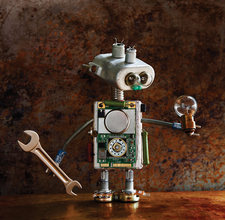Pi Zero as a universal USB stick
Multitool

© Lead Image © besjunior; 123rf.com
In just a few simple steps, you can turn a Pi Zero into a universal USB flash drive that emulates storage, a serial port, Ethernet, and more.
Instead of taking along a separate USB gadget for every task, you can turn a Pi Zero into a universal device that provides storage, a network interface, and additional functions. This project relies on a rarely used feature of the Pi Zero: Its USB port supports USB On-The-Go (OTG). If you connect the small-board computer (SBC) to another computer, the Raspberry Pi logs in as a lower-level device (gadget).
Normally gadget mode [1] is undesirable. If you want to connect a memory stick to the Pi Zero, you need a special OTG cable; otherwise, it will not work (see the "How OTG Works" box). Conversely, plugging a normal cable into the USB port triggers the desired behavior.
In Figure 1, the USB cable is plugged into the left-hand USB port and is used both to supply power and exchange data. If you want to reproduce the project without much effort, just from the software point of view, you can skip the next steps.
[...]
Buy this article as PDF
(incl. VAT)
Buy Linux Magazine
Subscribe to our Linux Newsletters
Find Linux and Open Source Jobs
Subscribe to our ADMIN Newsletters
Support Our Work
Linux Magazine content is made possible with support from readers like you. Please consider contributing when you’ve found an article to be beneficial.

News
-
Parrot OS Switches to KDE Plasma Desktop
Yet another distro is making the move to the KDE Plasma desktop.
-
TUXEDO Announces Gemini 17
TUXEDO Computers has released the fourth generation of its Gemini laptop with plenty of updates.
-
Two New Distros Adopt Enlightenment
MX Moksha and AV Linux 25 join ranks with Bodhi Linux and embrace the Enlightenment desktop.
-
Solus Linux 4.8 Removes Python 2
Solus Linux 4.8 has been released with the latest Linux kernel, updated desktops, and a key removal.
-
Zorin OS 18 Hits over a Million Downloads
If you doubt Linux isn't gaining popularity, you only have to look at Zorin OS's download numbers.
-
TUXEDO Computers Scraps Snapdragon X1E-Based Laptop
Due to issues with a Snapdragon CPU, TUXEDO Computers has cancelled its plans to release a laptop based on this elite hardware.
-
Debian Unleashes Debian Libre Live
Debian Libre Live keeps your machine free of proprietary software.
-
Valve Announces Pending Release of Steam Machine
Shout it to the heavens: Steam Machine, powered by Linux, is set to arrive in 2026.
-
Happy Birthday, ADMIN Magazine!
ADMIN is celebrating its 15th anniversary with issue #90.
-
Another Linux Malware Discovered
Russian hackers use Hyper-V to hide malware within Linux virtual machines.

